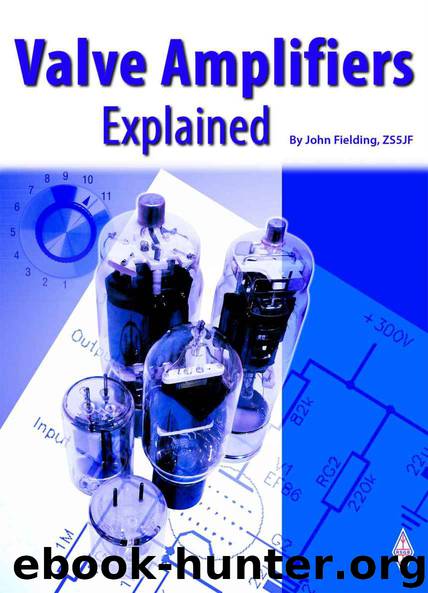Valve Amplifiers Explained by John Fielding

Author:John Fielding [Fielding, John]
Language: eng
Format: epub, mobi
Publisher: Radio Society of Great Britain
Published: 2017-10-11T21:00:00+00:00
Fig 10.6: Heathkit SB-230 cathode input network.
The cathode shunt resistor is rated at 30W and consists of many paralleled 2W carbon-composition resistors mounted on a tag strip board. The resistor is made from 15 x 1.5kΩ wired in parallel. These have a reputation of being too low a power rating and often they go higher in resistance due to over heating. Many amateurs have replaced the original 2W carbon composition resistors with more appropriate 3W metal-film resistors in an effort to gain some extra dissipation. The basic problem, however, is that the operator is not taking sufficient care with the drive level, and they often do not have the ALC hooked up to the transceiver. The 8873 valve needs at most ~40W to drive it into saturation on the lower HF bands and the typical 100W PEP transceiver simply has too much power.
A better method today would be a thin-film encapsulated heat sinkable resistor such as the types made for snubber resistors in switch-mode power supplies. These are available in up to 500W dissipation and are low inductance. A TO-220 packaged type is rated at 50W dissipation and 100Ω is a very common value for snubber resistors. Some of these resistors will work happily up to at least 1GHz and exhibit close to zero inductance at that frequency.
A comprehensive cure for the SB-230 would be to insert a power attenuator between the input and the cathode to dissipate the excess drive power and to stabilise the input Z. A 3dB/50W attenuator would be appropriate, with the ALC hooked to the transceiver to control the absolute drive level.
Download
This site does not store any files on its server. We only index and link to content provided by other sites. Please contact the content providers to delete copyright contents if any and email us, we'll remove relevant links or contents immediately.
On Writing A Memoir of the Craft by Stephen King(4889)
The Doodle Revolution by Sunni Brown(4709)
A Simplified Life by Emily Ley(4128)
Mummy Knew by Lisa James(3653)
Marijuana Grower's Handbook by Ed Rosenthal(3640)
Better Homes and Gardens New Cookbook by Better Homes & Gardens(3546)
Figure Drawing for Artists by Steve Huston(3406)
Paper Parties by Erin Hung(3395)
Draw Your Day by Samantha Dion Baker(3317)
The Genius of Japanese Carpentry by Azby Brown(3252)
Japanese Design by Patricia J. Graham(3134)
The Code Book by Simon Singh(3116)
Dangerous Girls by Haas Abigail(2994)
Lions and Lace by Meagan Mckinney(2940)
The Curated Closet by Anuschka Rees(2939)
How to Make Your Own Soap by Sally Hornsey(2862)
The Checklist Manifesto by Atul Gawande(2806)
The Wardrobe Wakeup by Lois Joy Johnson(2754)
Zero to Make by David Lang(2752)
